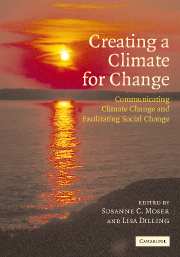Book contents
- Frontmatter
- Contents
- Preface
- Foreword
- List of contributors
- List of tables
- List of figures
- List of text boxes
- Introduction
- Part I Communicating climate change
- 1 Weather or climate change?
- 2 Communicating the risks of global warming: American risk perceptions, affective images, and interpretive communities
- 3 More bad news: the risk of neglecting emotional responses to climate change information
- 4 Public scares: changing the issue culture
- 5 The challenge of trying to make a difference using media messages
- 6 Listening to the audience: San Diego hones its communication strategy by soliciting residents' views
- 7 The climate-justice link: communicating risk with low-income and minority audiences
- 8 Postcards from the (not so) frozen North: talking about climate change in Alaska
- 9 Climate change: a moral issue
- 10 Einstein, Roosevelt, and the atom bomb: lessons learned for scientists communicating climate change
- 11 Across the great divide: supporting scientists as effective messengers in the public sphere
- 12 Dealing with climate change contrarians
- 13 A role for dialogue in communication about climate change
- 14 Information is not enough
- Part II Facilitating social change
- Part III Creating a climate for change
- About the authors
- Index
- References
10 - Einstein, Roosevelt, and the atom bomb: lessons learned for scientists communicating climate change
Published online by Cambridge University Press: 20 August 2009
- Frontmatter
- Contents
- Preface
- Foreword
- List of contributors
- List of tables
- List of figures
- List of text boxes
- Introduction
- Part I Communicating climate change
- 1 Weather or climate change?
- 2 Communicating the risks of global warming: American risk perceptions, affective images, and interpretive communities
- 3 More bad news: the risk of neglecting emotional responses to climate change information
- 4 Public scares: changing the issue culture
- 5 The challenge of trying to make a difference using media messages
- 6 Listening to the audience: San Diego hones its communication strategy by soliciting residents' views
- 7 The climate-justice link: communicating risk with low-income and minority audiences
- 8 Postcards from the (not so) frozen North: talking about climate change in Alaska
- 9 Climate change: a moral issue
- 10 Einstein, Roosevelt, and the atom bomb: lessons learned for scientists communicating climate change
- 11 Across the great divide: supporting scientists as effective messengers in the public sphere
- 12 Dealing with climate change contrarians
- 13 A role for dialogue in communication about climate change
- 14 Information is not enough
- Part II Facilitating social change
- Part III Creating a climate for change
- About the authors
- Index
- References
Summary
There has arguably never been a more critical moment in the history of communication between scientists and those in power than 1939. Physicists had demonstrated nuclear fission. Some speculated that uranium could be harnessed to trigger a chain reaction, unleashing the vast stores of energy locked inside the atom, and that this energy could be channeled to build a bomb with unprecedented destructive force.
The story of how a few prescient scientists convinced President Roosevelt of the danger and potential of the atom bomb is a fascinating case study, riddled with delays, uncertainties, and miscalculations that could be a cautionary tale for climate communicators. Many of the lessons to be drawn from that iconic episode almost 70 years ago echo themes familiar to climate change communicators.
What follows is an attempt to illuminate today's very different scientific urgency within this highly contrasting framework. The hope is that both the differences in context and substance and the sometimes-surprising similarities may provoke reflection on the difficulties of communicating the threats inherent in world-altering risks – the atom bomb on the one hand and the more slowly ticking time-bomb of climate change on the other.
In the narrow context of the story below, the communications campaign was a success – the scientists persuaded the government to build the bomb and, some argue, shortened the Second World War as a consequence.
- Type
- Chapter
- Information
- Creating a Climate for ChangeCommunicating Climate Change and Facilitating Social Change, pp. 167 - 179Publisher: Cambridge University PressPrint publication year: 2007
References
- 1
- Cited by



